This care sheet is available to provide basic information about keeping certain Australian Tree Frog species. Different species within this group have specific requirements and therefore this reference should only be used as a guideline.
Australian Tree Frog species belong to the genus Litoria, and most are arboreal (tree-living) species. These frogs are nocturnal and often spend the day sleeping, avoiding the hottest and driest times of the day.
They are a long-lived amphibious group, with some species reaching 20 years of age and can grow up to 14cm in length. Each adult female can produce an impressive 200-2000 eggs at any one sitting.
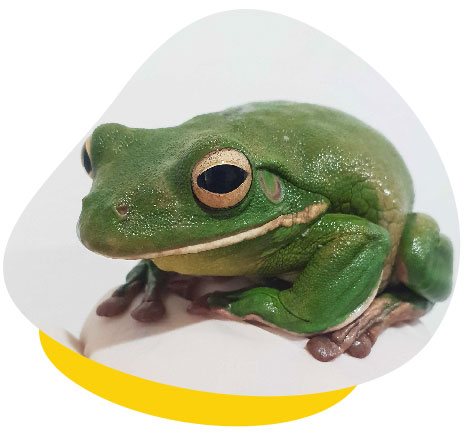
What do Australian Tree Frogs Eat?
An essential part of keeping Australian tree frogs is understanding their dietary requirements. Both adults and juveniles are insectivores and eat various live insects in the wild. Appropriate insects include crickets, cockroaches, earthworms, silkworms, slugs, moths, mealworms and wax worms. However, care must be taken with mealworms and wax worm portions, as these insects are very high in fat and overfeeding can lead to significant health problems.
All insects should be treated with calcium via gut-loading and or dusting before being fed. This is to prevent nutritional diseases such as metabolic bone disease resulting from chronically low calcium diets. This condition is very common amongst captive frogs.
The feeding of rodents and mince meats should generally be avoided in tree frogs, as these animals cope poorly with high protein diets and can develop kidney disease.
Adults should be provided 10-20% of their body weight each week in 2-3 separate feedings (i.e., offer insects every 2-3 days). Juvenile frogs should be fed more frequently (every day) but with smaller amounts.
Water access should be always provided, but simply using tap water may cause your frog to become sick. Tap water often contains chlorine and heavy metal additives that can be dangerous to frogs. The level of these chemicals can be decreased (or removed) with water conditioners (available at good pet stores).
Husbandry
As arboreal animals, tree frogs require different levels in their enclosure, which can be achieved with fake plants, bamboo, tree branches or PVC pipes.
Enclosure
The enclosure walls are best made from glass or Perspex, and where possible, it is good to have the roof of the enclosure made from a safe, breathable mesh (materials that rust or can injure the frogs should be avoided) as this allows ventilation.
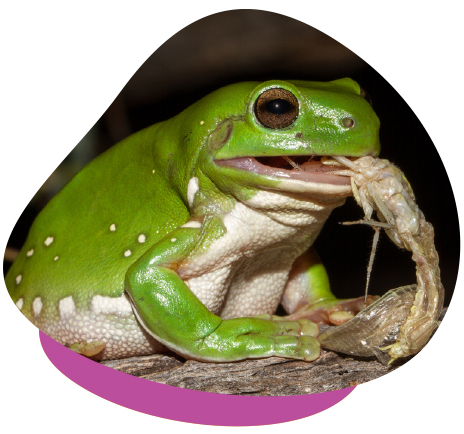
Lighting Requirements
UV lights come in various sizes and shapes but are essential for captive frogs.
Appropriate UV lighting allows frogs to metabolise calcium, and without a good source of UV, frogs can develop metabolic bone disease. A frog should be able to bask within 20cms of the UV light for it to be effective. Depending on the type and brand of UV globe, this must be changed every six to twelve months to ensure your frog is receiving enough light (over time, the UV output of the globe decreases).
The strength of UVB is also important with lower levels required for amphibians. Following the guidelines set out by the manufacturer can be of assistance when choosing your UVB globes or of course you can discuss this with your amphibian veterinarian.
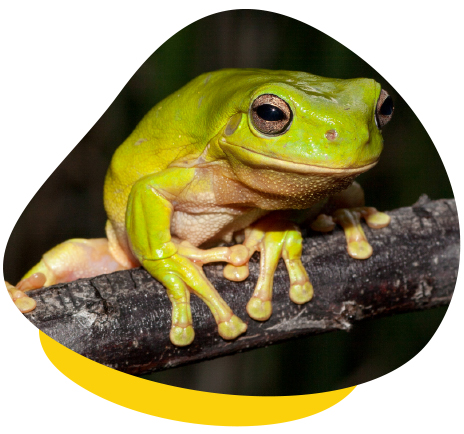
Temperature
The thermal gradient temperature in the cage should generally be between 18°C (at the cooler end) to around 32°C at the warmer with some species preferring slightly cooler upper range temperatures. The frog can self-regulate its temperature by having a temperature gradient.
Any heat sources – whether you use a heat matt or heat lamp – should be placed on a thermostat to prevent dangerous fluctuations in the temperature from occurring.
Humidity
Another important aspect of your frog’s environment is the humidity. Humidity can be increased by using air pumps or bubblers for smaller cages, but sprinklers, waterfalls, and living plants are often required and recommended for larger enclosures.
The humidity for most species should be kept between 50-70%. Higher humidity’s increase the risk of some fungal and bacterial infections. For small water containers, daily changes are recommended. For larger water provisions, if no living plants or filtration systems are being used, the water in the enclosure should be changed at least weekly. This can be extended to fortnightly if appropriate filtration is present.
A small percentage (i.e., 20%), regular water changes are better than a large percentage, infrequent changes.
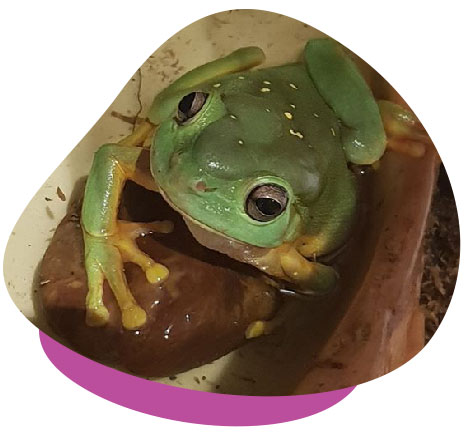
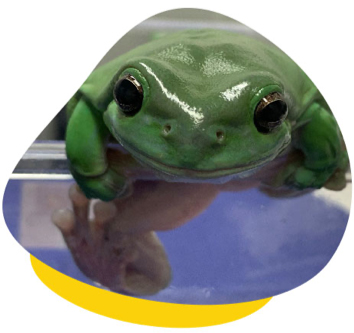
Substrate
As for the substrate (what type of flooring to use), in general, avoid abrasive and ingestible substrates. Some suitable substrates include sphagnum moss, foam rubber, large rocks, or moist paper towels (for smaller enclosures).
Common Diseases
Below are some of the common conditions seen in pet tree frogs.
- Fungal and bacterial infections
- Internal parasites
- Malnutrition / Metabolic bone disease
- Obesity
- Trauma
We recommend health checks for frogs every 6-12 months.
For more information on caring for Australian Tree Frogs, get in touch with your local Unusual Pet Vets team.

